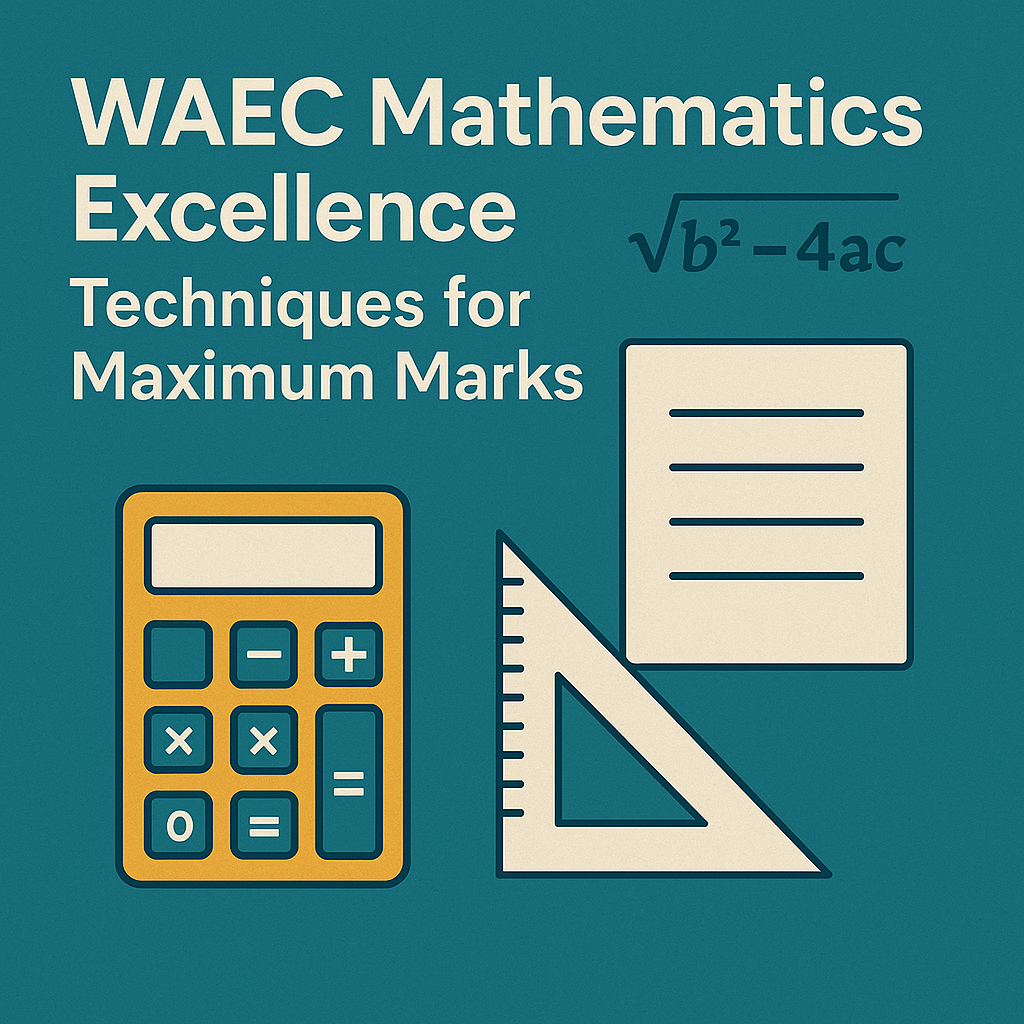1. Introduction
Mathematics in WAEC is crucial for science, engineering, and economics aspirants, contributing significantly to students’ grades. Achieving a high score requires a balance of conceptual clarity and methodical problem-solving.
This guide outlines a stepwise approach: understand the WAEC math syllabus, master core topics number theory, algebra, geometry, statistics and apply exam-centric strategies. We’ll delve into practice techniques, time management tips, and resource recommendations to elevate your performance.
By adhering to structured study plans and targeted practice, you’ll transition from uncertainty to mastery. Let’s embark on the path to WAEC math excellence.
2. Deep Dive: Syllabus & Topic Breakdown
2.1 Number Theory & Arithmetic
- Topics: HCF and LCM, surds, percentages, ratio and proportion.
- Techniques: Prime factorization, simplifying radicals, mental math shortcuts.
Example Drill
Simplify √50 + √18 – √8 by extracting square factors: = 5√2 + 3√2 – 2√2 = 6√2.
2.2 Algebra & Functions
- Equations: Linear, simultaneous, quadratic; functions and graphs.
- Inequalities: Solving and graphing; absolute values.
Key Formulae
| Topic | Formula/Rule |
|---|---|
| Quadratic Roots | x = [–b ± √(b² – 4ac)]/(2a) |
| Function Notation | f(x + h) – f(x) = Δy/Δx slope concept |
2.3 Geometry & Trigonometry
- Plane Geometry: Angles, circles, polygons, area, perimeter.
- Coordinate Geometry: Distance, midpoint, slope, equation of line.
- Trigonometry: Ratios, identities, heights and distances.
Worked Problem
Calculate the area of a triangle with coordinates (0,0), (4,0), (4,3) using the shoelace formula: = 6 units².
2.4 Statistics & Probability
- Data: Mean, median, mode, variance, standard deviation.
- Probability: Single and combined events; tree diagrams.
Quick Tip
Use the complement rule P(A’) = 1 – P(A) to simplify multi-step probability problems.
3. Exam Strategy Tips
3.1 Time Management
- Total: 2 hours; allocate ~15 minutes per section based on weight.
- Prioritize quick questions to build momentum; flag complex ones.
3.2 Problem-Solving Framework
- Understand: Parse question; list knowns and unknowns.
- Plan: Select appropriate theorem or formula.
- Solve: Write clear, logical steps.
- Review: Check numeric accuracy and units.
3.3 Eliminating Incorrect Options
- Estimate bounds: e.g., area or volume cannot be negative.
- Use unit digit checks for quick validation in numerical questions.
3.4 Use of Diagrams
- Sketch figures accurately; label all known measures.
- For trigonometry, draw right triangles to visualize ratios.
3.5 Avoiding Careless Errors
- Re-read questions; ensure solving for correct variable.
- Keep consistent notation (e.g., x vs y).
4. Subject-Specific Overview
4.1 Number Theory Mastery
- Practice LCM/HCF via Euclidean algorithm for speed.
4.2 Algebraic Techniques
- Factorization shortcuts: difference of squares, perfect square trinomials.
4.3 Geometric Insights
- Leverage symmetry and known polygon properties to reduce computation.
4.4 Statistical Reasoning
- Interpret real data sets; practice reading and constructing histograms.
5. Practice & Resources
5.1 Textbooks
- WAEC Mathematics Cruncher by Mega Education
- Target WAEC: Mathematics by Frontline Publishers
5.2 Online Platforms
| Resource | Features | Access |
|---|---|---|
| ExamMate | Topic-based quizzes | Free/Paid |
| Past Questions | Full question banks | Free |
| GeoGebra | Geometry and graphing tools | Free |
5.3 Mobile Apps
- MathsPrep WAEC: Practice tests and flashcards.
- Photomath: Step-by-step solutions via camera.
5.4 Mock Exam Strategy
- Bi-weekly full-length timed exams.
- Analyze error types: conceptual vs computational.
6. Conclusion
Excelling in WAEC Mathematics combines structured practice, strategic problem-solving, and disciplined exam techniques. By mastering number theory, algebra, geometry, and statistics reinforced with targeted drills and mock exams you’ll achieve both speed and accuracy.
Implement daily practice sessions, utilize varied resources, and monitor progress to refine your approach. Begin today with a focused 20-minute session on your weakest topic; your path to WAEC math mastery starts now.
